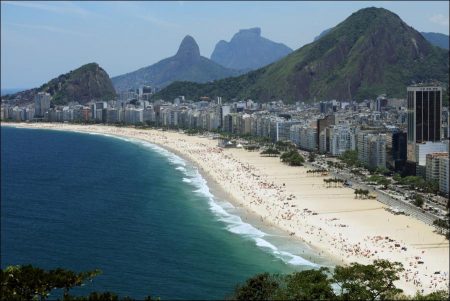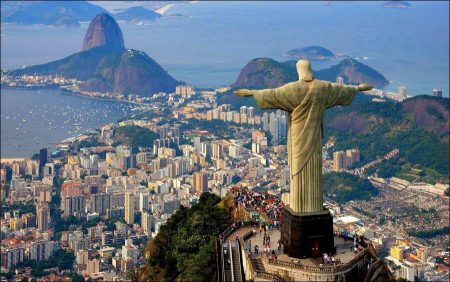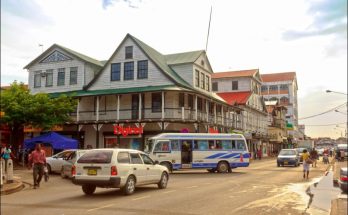From the streets during February’s Carnival to afternoons on Copacabana Beach, life in this Brazilian city is infused with the sounds of samba and the search for the good life.
Rio de Janeiro is almost impossibly marvellous, with its curving white beaches and city neighbourhoods studded with green-shrouded mountains, all facing the blue depths of the Atlantic Ocean. The city is being transformed, as a booming economy and decreasing crime rates attract those who like to work and play hard. From the city streets during February’s Carnival to afternoons on Copacabana Beach, life here is infused with the sounds of samba and the search for the good life.
What is it known for?
The girl from Ipanema is still walking and the views from Sugarloaf Mountain on the city’s Guanabara Bay are as sweet as ever, but its Rio’s future that is the buzz right now. The city, like the rest of Brazil, is booming, not only due to the recent discovery of off-shore oil fields, but also because two huge global events are coming to Rio over the next few years. The city will host the 2014 World Cup finals and the 2016 Summer Olympics, and Rio is experiencing massive construction projects, including the rehabbing of neighbourhoods, transport and sporting venues.
The famous Maracana football stadium, one of the largest in the world, is undergoing a total renovation expected to be completed in 2013 before it hosts the World Cup kick off in June 2014 and the Olympic opening ceremony in August 2016. The Metro is being expanded and new areas of the city are being constructed. For example, the Porto Maravilha, an eight billion reais project due to be completed by 2016, is stitching the revitalised Guanabara Bay harbourfront to the downtown district. The project will see the demolition of an elevated highway, the planting of 15,000 trees and construction of the Museum of Tomorrow, designed by Santiago Calatrava and set to open in 2014.

A number of the city’s famous favelas (slums), which have contained so much of Rio’s poverty and poetry, have been steadily becoming safer since the state created a new police force in 2008 that quelled much of the violence. Rents and property prices are rising so quickly in these hillside neighbourhoods – which offer up stellar views – that poorer residents cannot afford it and as such, are being forced out.
Despite all the changes taking place citywide, cariocas (residents of Rio) still gather late into the night and sway to the samba music that pours out of bars and cafes in rejuvenated neighbourhoods like Lapa in the south of the city. “Most people are very friendly and open,” said Claudia Solano, a lifelong resident. “In comparison to São Paulo, it is laid-back here, even in sophisticated places.”
uh4>Where do you want to live?
Traditionally the flat areas of the city, such as the wealthy Zona Sul (South Zone), have been the most desirable places to live. “Rich Brazilians and international buyers prefer the neighbourhoods of Leblon, Ipanema, Jardim Botanico and Lagoa, while middle-income residents buy or rent in Copacabana, Botafogo, Flamengo, Laranjeiras and Largo do Machado,” explained Robson Lemos, associate broker at the Corcoran Group. In downtown Rio and the nearby Porto Maravilha, many developments are in the pipeline. “Zoning changes allowed for [building] heights to go from four floors to up to 50 floors on the waterfront, attracting big international developers such as Donald Trump and others,” Lemos said.
Barra da Tijuca in the city’s western zone is a planned district with high-rises and modern infrastructure that will be home to the Olympic Arena, where events like gymnastics will be held, and the Olympic Aquatics Stadium. The district attracts families looking for large apartments who are priced out of Zona Sul.
“You’ll find larger places for a better price,” Solano said. “The metro will get out there eventually, but having a car is a must and traffic jams are routine.” Middle-class neighbourhoods such as Tijuca and Meier in the Zona Norte (North Zone) are also very popular. “Cariocas say that Zona Norte has more of the flavour of old Rio,” Lemos said. Many people commute from Niteroi, a mid-sized city connected to Rio by bridge across Guanabara Bay.
Side trips
When you live in Brazil, you are spoiled for choice when it comes to beaches. Many residents head to towns in the Lake Region such as Buzios and Cabo Frio, both about 150km north of Rio. Around 150km south of Rio, the municipality of Angra dos Reis attracts cariocas to its hundreds of islands, including the spectacular rainforests and white sands of Ilha Grande. Inland, the mountain town of Petropolis is just 70km from Rio, once the summer residence of the royal family and now a popular weekend destination for its restaurants and resorts.
Flights to Sao Paulo are less than an hour and most fly from Aeroporto Santos Dumont, along with other domestic service to cities like Brasilia. The Aeroporto Internacional do Galeao has connections to 19 countries and regional service to other South American capitals. The flight to Buenos Aires is just more than two hours and Miami is around eight hours away.
Practical info
After a meteoric 165% rise in prices over three years, the real estate market slowed slightly in 2012, but prices continue to go up. “Overall the entire market got higher, including the low end,” Lempos said. “International buyers and wealthy Brazilians are buying in Rio to add to their real estate portfolio.”
Increased investment has also lead to the new construction of apartment blocks and commercial buildings all over the city. “Many investors are buying old houses, vacant lots and small buildings in order to build bigger and taller buildings,” Lempos said.
A 100sqm, two-bedroom apartment in Leblon or Ipanema starts at around two million reais, while renting something similar costs between 8,000 to 20,000 reais a month. Equivalent flats in less expensive Zona Sul neighbourhoods like Santa Teresa, Flamengo and Botafogo are about half that.
Visits: 137



